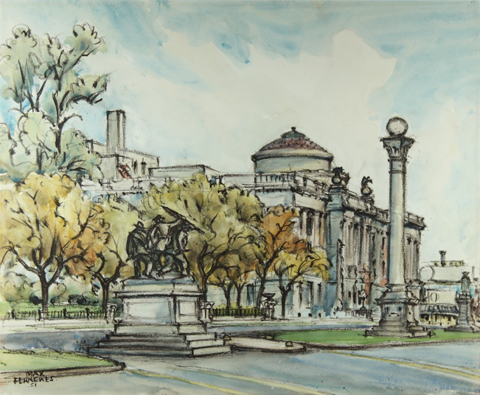
In the City
Past Exhibition
August 29–December 5, 2021
Saint John’s on the Lake
How do we form our impressions of a city’s character? Landmark buildings? Streets? The people? Individually and collectively, such components comprise the urban environment, and they have provided endless inspiration for numerous artists.
Max Fernekes focuses on the street level with his depiction of Milwaukee’s Central Library and the railway station. The former still exists, the latter is but a fond remembrance. The same nostalgia applies to Gerrit Sinclair’s and Howard Thomas’s portrayals of Jones Island, the fishing enclave that vanished in the 1940s but remains part of local lore. Willi Knapp was entranced by the everyday street activities and individual neighborhoods that still mark the city today; Gibson Byrd’s busy street crossing follows suit, but sounds a more contemporary note.
In the late nineteenth and early twentieth centuries, Milwaukee built its reputation as an industrial city. Huge factories served to illustrate the dramatic contrast between human and industrial scale and entranced artists such as Antoinette Gruppe and Earl Gessert.
Fred Berman took a more abstract approach to imbue his cities with an almost mythical appearance, while Arthur Thrall and Ida Ozonoff moved in to take a close, granular look at the textures that form the essence of the urban environment.
Change is continual and cities are not immune. We experience the ongoing flow as buildings and people come and go, but our impressions are rooted in memory as well as the here and now.
